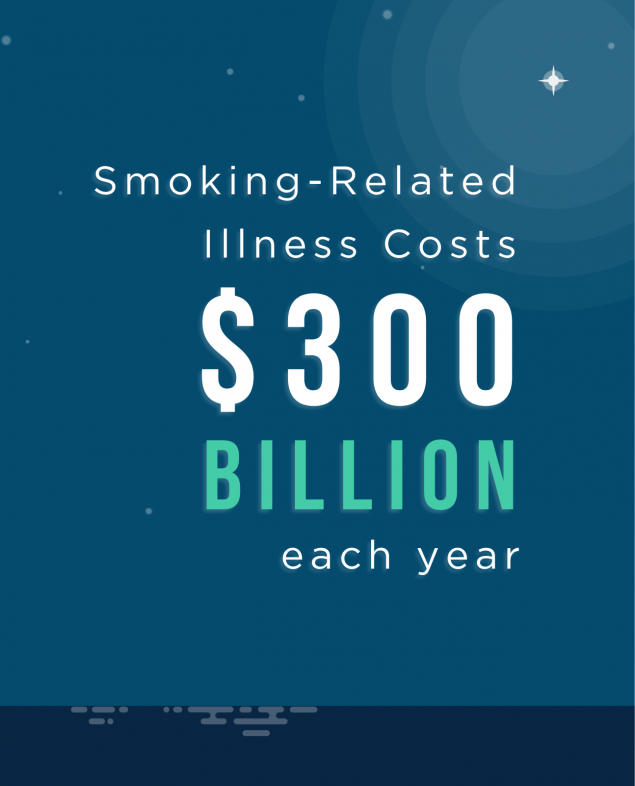Health Topics – Tobacco

Overview
Tobacco use is the single most preventable cause of disease, disability, and death in the United States. Cigarette smoking causes more than 480,000 deaths in the United States every year, including approximately 41,000 nonsmoking adults and 400 infants who die from secondhand smoke exposure. Although cigarette smoking has declined considerably among U.S. adults over the past half century, an estimated 34 million U.S. adults currently smoked cigarettes in 2019. Moreover, in 2020, 4.5 million U.S. middle and high school students currently used some form of tobacco product. In addition, disparities in tobacco use persist across population groups, including by race/ethnicity, socioeconomic status, and across regions of the country.
Economic Burden
Smoking-related illness in the United States costs over than $300 billion each year—about $225 billion for direct medical care for adults and more than $156 billion in lost productivity, including $5.6 billion in lost productivity due to secondhand smoke exposure.
Risk Factors
Cigarette smoking remains high among certain groups, including:
Adults with lower educational levels
Men
Adults 25-64 years old
Adults living in the South and Midwest
Adults living below the poverty level
Adults with a disability/ limitations
Adults who are uninsured or have Medicaid
Adults with mental health or substance abuse disorders
American Indian and Alaska Native adults
Lesbian, Gay, and Bisexual adults

Expanding Access to Evidence-Based Tobacco Treatments that Help People Quit
Tobacco use can be reduced by increasing access to evidence-based treatments, such as behavioral counseling and medication that help people quit. The Community Preventive Services Task Force recommends policies and programs to reduce out-of-pocket costs for evidence-based cessation treatments based on strong evidence of effectiveness in increasing the number of tobacco users who quit. Additionally, health-system level interventions, such as integrating tobacco use screening and treatment into routine clinical care, can support providers in helping patients quit.
Raising the Price of Tobacco Products
Increasing the price of tobacco products is one of the most effective ways to reduce consumption. A 10% increase in price has been estimated to reduce adult cigarette consumption by 3–5%. Research on cigarette consumption suggests that both youth and young adults are two to three times more likely to respond to increases in price than adults. The Community Preventive Services Task Force recommends interventions that increase the unit price of tobacco products based on strong evidence of effectiveness in reducing tobacco use.
Implementing Hard Hitting Media Campaigns to Educate the Public about the Harmful Effects of Tobacco Use and the Benefits of Quitting
Mass-reach health communication interventions access large audiences through television and radio broadcasts, print media (e.g., newspaper), out-of-home placements (e.g., billboards, movie theaters, point-of-sale), and digital media to change knowledge, beliefs, attitudes, and behaviors affecting tobacco use. The Community Preventive Services Task Force recommends mass-reach health communication interventions based on strong evidence of effectiveness in decreasing the prevalence of tobacco use and increasing cessation and use of available services, such as quitlines.
For example, CDC’s Tips From Former Smokers® (Tips®) campaign profiles real people who are living with serious long-term health effects due to smoking cigarettes and secondhand smoke exposure. The Tips campaign serves as an important counter to the $8.2 billion that was spent on advertising and promotion of cigarettes and smokeless tobacco in 2019—more than $22 million every day, or nearly $1 million every hour. For every $3,800 CDC spends on Tips ads, one death is prevented. From 2012 to 2018, CDC estimates that more than 16.4 million people who smoke have attempted to quit and approximately one million have successfully quit because of the Tips campaign.
Enacting Comprehensive Smoke-Free Policies that Prohibit Smoking in all Indoor Areas of Workplaces and Public Places
Significant disparities exist in secondhand smoke exposure, impacting non-Hispanic Black Americans; people who live below the federal poverty level; those who work in traditionally “blue collar” industries, service occupations, or construction; people who live in multi-unit housing; and children, particularly those aged 3-11 years. Smoke-free policies include government policies and private-sector rules that prohibit smoking in indoor spaces and public areas. State and local ordinances often establish smoke-free standards for indoor spaces, including workplaces, restaurants and bars. Private-sector policies may include tobacco-free campus policies that prohibit all tobacco use at a company’s buildings and grounds. There is no safe amount of exposure to secondhand smoke. The Community Preventive Services Task Force recommends smoke-free policies to reduce secondhand smoke exposure and tobacco use. In addition to reducing secondhand smoke exposure, smoke-free policies can also promote smoking cessation, prevent smoking initiation, and reinforce smoke-free norms.
Point-of-Sale-Focused Strategies
An estimated 375,000 retailers sell tobacco products across the US. Point-of-sale strategies that focus on the retail environment have potential to further advance tobacco prevention and control efforts. These strategies include: product availability; pricing and promotion; advertising and display; age of sale; and retail licensure.
Featured Resources
Scientific evidence briefs provide a summary of the recent science and evidence-based best practices or policy options on select tobacco prevention and control interventions.
CDC’s 6|18 initiative provides health care partners with rigorous evidence about high-burden health conditions and associated interventions to inform their decisions to have the greatest health and cost impact. This summary provides a look at tobacco use in the United States, evidence of the effectiveness of prevention programs, and current payer coverage for these programs.
Targeted, action-oriented information for stakeholders
Most states have some tobacco control laws or programs but not have taken a comprehensive approach. Comprehensive programs have a greater population health impact and the proven potential to generate savings greater than their implementation costs. To maximize health and economic benefits, CDC recommends investments in comprehensive statewide tobacco control programs and offers technical packages contain targeted, action-oriented information for stakeholders interested in advancing population health strategies.
An evidence-based guide to help states plan and establish comprehensive tobacco control programs
The Best Practices for Comprehensive Tobacco Control Programs is an evidence-based guidance document which helps states build and maintain effective tobacco control programs to prevent and reduce tobacco use. The document describes an integrated programmatic structure for implementing interventions proven to be effective and provides the recommended level of state investment to reach these goals and to reduce tobacco use in each state. Other User Guides include: Cessation, Health Communication, Health Equity, Program Infrastructure and Youth Engagement.
As part of the 2014 Best Practices for Comprehensive Tobacco Control Programs, CDC highlights evidence-based strategies states can engage in health systems change work. This document has frequently asked questions about health systems change that are intended to help state tobacco control programs plan and implement health systems change initiatives.
Surgeon General’s Report on Smoking Cessation
In 2020, the U.S. Surgeon General released a comprehensive report on smoking cessation, the first Surgeon General’s Report on the topic in 30 years. The report makes it clear that one of the most importance actions people can take to improve their health is to quit smoking. This is true regardless of their age or how long they’ve been smoking. This report and its associated fact sheets outline the latest research on clinical treatments and population-level strategies that have been proven to help people successfully quit smoking. It also discusses new ways in which we can promote and support cessation.
Featured Tools
Tobacco-related data in an online, easy to use, interactive application (OSHData)
A comprehensive tobacco prevention and control data in an online, easy to use, interactive data application. You can explore popular datasets, charts, and maps, and you can view/print STATE System fact sheets.
Interactive state-level data in the State Tobacco Activities Tracking and Evaluation (STATE) system
An interactive application that presents current and historical state-level data on tobacco use prevention and control. Build your own reports by selecting the topics, states, and years of data. Explore the State Highlights report to see a variety of data from across the system for a single selected state. Use Interactive Maps to access key data from across the System in a US map and data table.
For more information on tobacco-related topics, visit www.cdc.gov/tobacco/

